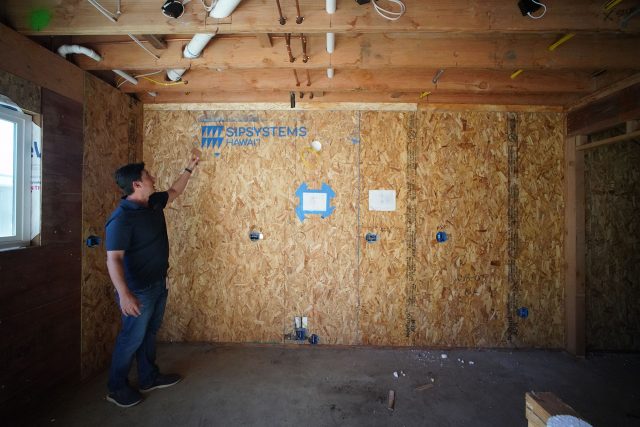
Feb. 22, 2022
The entire structure of a home can go up in days using structural insulated panels, so why are we hardly using it?
Struggling To Get By project badgeSIP Systems Hawaii is using an innovative building material — structural insulated panels — that cuts labor costs, significantly reducing the price of the home. A house can be built with the prefabricated panels in less than a week, company officials say.
Home construction costs in Hawaii average between $295 and $785 per square foot, according to the Rider Levett Bucknall construction cost indicator. So, based on the mid-point of $540, building an 1,800-square-foot single-family home in Honolulu would cost nearly $1 million — that’s if the developer did not mark up the house for resale.
Compare that to a house twice that size, for example the 3,500-square-foot home on 10th Avenue that SIP Systems Hawaii has in the works: its projected construction costs are on the lower end at $300 per square foot, so about $1.1 million for a home twice the size.
“It’s really hard to compare the total costs, but our biggest savings is for labor on the framing and saving monthly on energy efficiency,” said SIP Systems Hawaii co-founder Brian Enomoto.
SIP Systems VIP of sales Brian Enomoto shares about the sustainability of their wood products at a project located at 1824 10th Avenue.
SIP Systems Hawaii co-founder Brian Enomoto talks about the sustainability of the wood products at a residential project located on 10th Avenue in Kaimuki.
Housing advocates hope pre-fab construction can translate into more people owning homes in Hawaii.
The state has the nation’s fourth lowest homeownership rate at 58%, behind only the District of Columbia, New York and California, according to fourth quarter 2021 census data.
Using a cheaper building material that takes less time to put up could help.
Hawaii's Changinge Economy Special Project Badge
Carolyn Hyman, a spokeswoman for Aloha United Way, which is working to find solutions to Hawaii’s high cost of living, said generating less expensive housing is what locals need.
“We need to give households the capacity to save and if we can do that by generating more safe and affordable housing, it would move the needle a lot for people here in Hawaii,” Hyman said.
But the nationwide spike in supplies like lumber, copper and cement hardly makes homebuilding seem like a thrifty solution.
The cost of building materials has grown exponentially since the pandemic, up 23% between 2020 and 2021, according to the U.S. Bureau of Labor Statistics, and that doesn’t even factor in shipping costs to Hawaii.
“Obviously, our labor costs are up, we don’t have all the material we need and I have a ton of guys calling in sick every week,” said local contractor Lex Allen with Solid Build Construction Inc.
SIP Systems argues that its material can give builders like Allen needed wiggle room. The cost of framing is a case in point. A study conducted by BASF and RSMeans Business Solutions found builders could reduce their framing labor as much as 55% by using SIPs instead of traditional methods. And SIP Systems’ experience is bearing that out, Enomoto said.
For instance, a traditional framing system for the home the company is building in Kaimuki would take 1,200 to 1,500 man-hours to build, Enomoto said. By contrast, the framing for SIP Systems’ home took 344 man-hours or four days to build, resulting in a savings of about $50,000, he said.
SIP Systems VIP of sales Brian Enomoto shares about the sustainability of their wood products at a project located at 1824 10th Avenue.
The home on 10th Avenue, made entirely of structural insulated panels, went up in four days. Contractors are now working to install appliances, build interior framing and set up electric and water.
Cory Lum/Civil Beat/2022
Enomoto’s company plans to have five to 10 pre-made home designs that people can choose from.
But the workers who build the homes are, understandably, not thrilled with the idea of smaller paychecks. They need the work to feed their own families and pay their own bills.
Kyle Chock, executive director of PRP, an advocacy group for union carpenters and contractors, said in a statement that technological advancements such as SIP panels could depress worker’s wages and speed up the out-migration of good paying working class jobs.
The average construction job in Hawaii paid about $45 an hour in December, according to the U.S. Bureau of Labor Statistics.
“The inflation rate has hit the highest rate in nearly 40 years and local wages weren’t keeping up even prior to that,” Chock said.
He noted the irony that working-class people wouldn’t be able to afford a home if their wages can’t support it.
But Enomoto stressed that the company’s product isn’t eliminating construction jobs. It’s just letting workers build faster. So an increase in the number of homes going up would make up for fewer man-hours per job.
“We need 25,000 homes by 2025,” Enomoto said, referring to government predictions that the state will need 26,000 homes in the next few years. “We’re not eliminating any jobs, we’re just speeding it up.”
SIP panels construction
Typical SIP panel configuration published in a study that compares wood framing to SIP panel construction.
Screenshot: Seismic-Resistant Building Design
So what exactly are SIPs? They were developed in the 1930s and consist of two thick plywood-like boards made from pieces of small-diameter trees with a highly condensed styrofoam core in between.
Unlike typical frame construction, SIPs work like building blocks, said Aaron Smith, CEO of GreenSmith Builders, a Minnesota home building company that’s building an 54,000-square-foot apartment complex out of SIPs. The panels are designed and manufactured offsite and placed together in days to form the structure.
But structural insulated panels aren’t made in Hawaii because there’s no facility here. Shipping costs increase the price, and supply chain woes can make it hard to get the panels quickly.
Enomoto said he sends design plans to his SIP manufacturer in Washington, which cuts the boards and ships the massive panels back to Hawaii for assembly.
But not everybody thinks SIP is Hawaii’s housing solution. Greg Thielen, CEO of Complete Construction Services Co. and former director for the state Building Industry Association said he remains skeptical.
“The vast majority of homes throughout the country, not just in Hawaii, are still stick framed,” he said. “These companies that are doing the stick framing, would drop it in a heartbeat if they found a system that actually made them more money or made them the same amount of money faster.”
Thielen said he believed the efficacy and structural capacity of SIPs to outperform traditional framing as stated in a study by the Engineered Wood Association, but noted that it’s a solution that could work better on the mainland with closer proximity to manufacturers and greater demand.
Former Hawaii resident and SIP homeowner Zane Watson said the panels could be a great solution for Hawaii residents.
Watson, president of Made Rite, a snap-on baseboard system, already considers himself someone that embraces different solutions. So, when he moved from Oahu to Washington state in 2020, he decided to build his home entirely out of SIP panels.
While he and his wife have decided they want to ditch the cold for Mexico, recently listing their home for $2.3 million, Watson said he loves his home.
“My walls are straight, the sound stays in, I never hear noise outside my house and we don’t need an AC unit because the house stays pretty cool,” he said.
And perhaps best of all, it cost him only about $100,000 in labor to put together.
“I had my walls, a roof on and everything done in five days,” he said.
